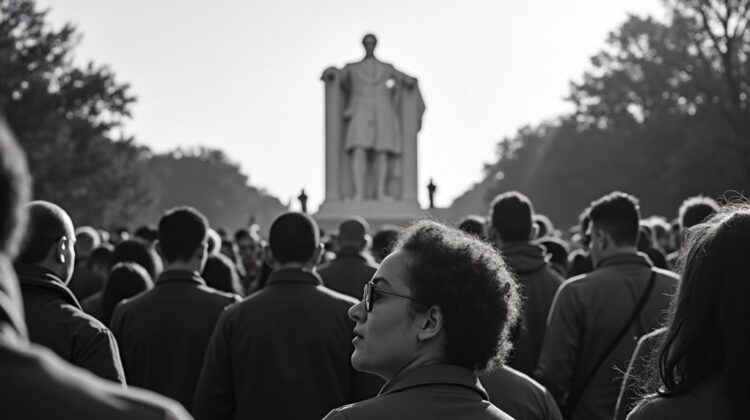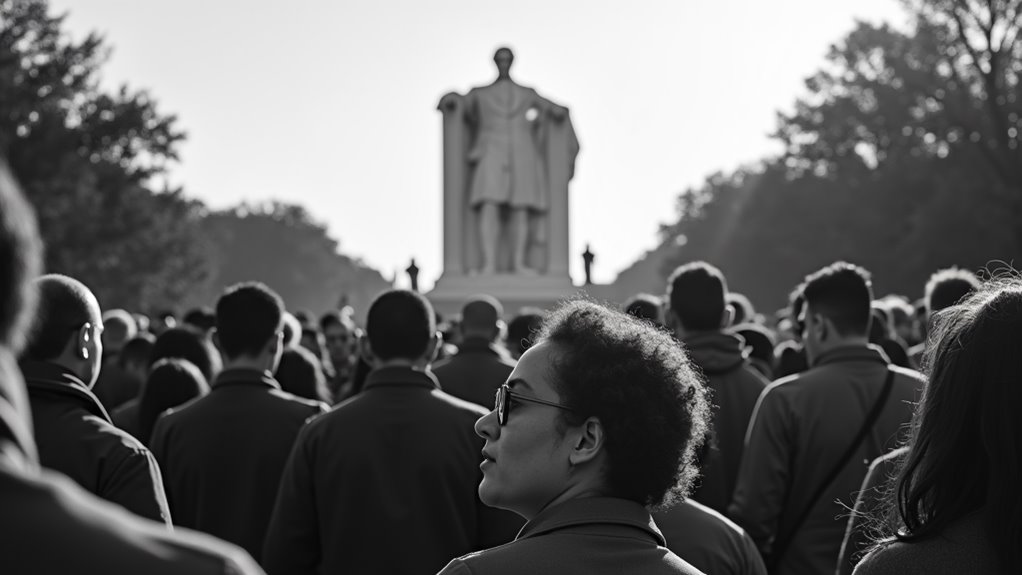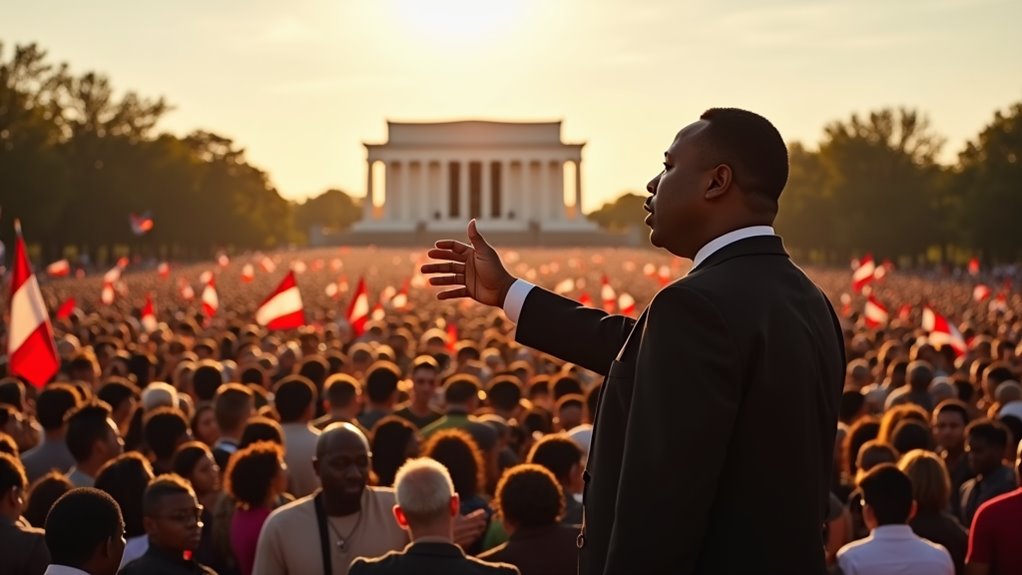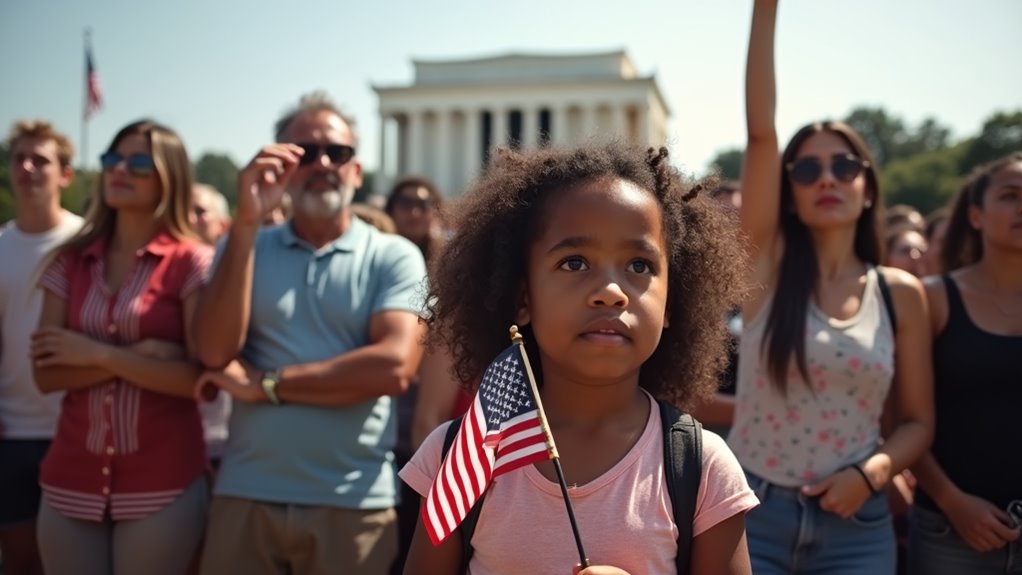
Martin Luther King Jr.'s "I Have a Dream" speech, delivered during the 1963 March on Washington, articulates a vision for racial equality and justice. The address, which highlights the need for immediate action against injustice, employs strong rhetorical techniques like repetition and vivid imagery. Its immediate positive response solidified its place in American history, making it a cornerstone of the civil rights movement. Comprehending its themes and impact reveals deeper insights into King's enduring legacy.
Table Of Contents
Article Highlights
- Delivered during the 1963 March on Washington, King's speech called for civil rights, economic opportunities, and racial equality for all Americans.
- The speech emphasizes the need for immediate action against racial injustice and envisions a future where individuals are judged by their character.
- Key rhetorical techniques include repetition, vivid imagery, and biblical allusions, enhancing the emotional impact and urgency of the message.
- The title evolved from "Cashing a Cancelled Check" to "I Have a Dream," reflecting a shift towards hope and unity in the civil rights movement.
- Widely regarded as a pivotal moment in American history, the speech shaped public perception of civil rights and remains influential today.
Background of the Speech

The "I Have a Dream" speech, delivered by Martin Luther King Jr. on August 28, 1963, emerged from a pivotal moment in American history. This landmark address was presented during the March on Washington for Jobs and Freedom, which drew approximately 250,000 attendees advocating for civil rights and economic opportunities for African Americans. Inspired by the centennial of the Emancipation Proclamation, King spoke from the steps of the Lincoln Memorial, honoring President Abraham Lincoln's commitment to equality. Originally titled "Cashing a Cancelled Check," the speech highlighted the stark contrast between the American Dream and the reality of racial injustice. Through the influential refrain of "I Have a Dream," King emphasized the collective yearning for freedom and equality within the civil rights movement.
The Writing Process and Title
The title of Martin Luther King Jr.'s iconic speech evolved from "Cashing a Cancelled Check" to the more resonant "I Have a Dream," reflecting a shift in focus toward hope and unity. This transformation underscores the significance of the speech's message, in addition to King's extensive drafting and revision process, which incorporated elements from his previous works. In the end, the final version emerged as a strong narrative that captured the aspirations of the civil rights movement.
Title Evolution and Significance
Evolution of a title can provide profound insight into the underlying themes of a work, particularly in the case of Martin Luther King Jr.'s iconic speech. Originally titled "Cashing a Cancelled Check," the title emphasized the unfulfilled promises of the American Dream for African Americans and highlighted economic injustices. The eventual title, featuring the famous refrain "I have a dream," emerged from a synthesis of earlier drafts and speeches, including a notable address in Detroit. This refrain, repeated eight times, underscored King's vision for equality and justice, resonating profoundly during the March on Washington for Jobs and Freedom. By evoking ideals associated with Abraham Lincoln, King's speech became an enduring symbol of the Civil Rights Movement, representing hope for a more equitable future.
Drafting and Revision Process
Crafting a strong speech requires careful drafting and revision, a process that Martin Luther King Jr. exemplified in his iconic "I Have a Dream" address. Initially titled "Cashing a Cancelled Check," the speech addressed unfulfilled promises in civil rights. King's exploration of dreams began in 1960, culminating in the potent refrain "I have a dream" that resonated during his delivery on August 28, 1963. This final version emerged from multiple drafts, including a significant Detroit address in June 1963. King's speechwriting process involved extensive revisions, incorporating rhetorical devices like anaphora to improve emotional impact. Influenced by historical documents such as the Declaration of Independence, King underscored the continuity of the civil rights struggle throughout American history.
Key Themes and Messages

At the heart of Martin Luther King Jr.'s "I Have a Dream" speech lies a potent vision of racial equality and justice. This vision emphasizes that individuals should be judged by their character rather than their skin color, nurturing hope for unity among all Americans. King articulates the urgency of the civil rights movement, insisting on immediate action against racial injustice. Through the repetition of "I have a dream," he reinforces his aspiration for a society where freedom and justice prevail. By connecting the struggle for civil rights to foundational American ideals, King highlights the failure to realize these promises for African Americans. In the end, his call for collective action urges people of all races to unite in the pursuit of justice and equality.
Rhetorical Techniques Employed
In his "I Have a Dream" speech, Martin Luther King Jr. masterfully employed repetition to emphasize his vision, particularly through the repeated phrase "I have a dream." Furthermore, he incorporated biblical allusions and vivid imagery, which not merely resonated with his religious audience but also strongly conveyed the moral urgency of the civil rights movement. These rhetorical techniques served to inspire hope and nurture a shared sense of purpose among listeners.
Repetition for Emphasis
Repetition serves as a cornerstone of Martin Luther King Jr.'s rhetorical strategy, effectively amplifying his message of racial equality and justice. By repeating the phrase "I have a dream" eight times, King underscored his vision as he instilled a sense of urgency within the civil rights movement. His use of anaphora heightened the emotional impact of key ideas, crafting a rhythmic cadence that resonated deeply with his audience. Phrases like "Now is the time" reinforced the necessity for immediate action, as "Let freedom ring" called for unity and liberation among all people. This strategic repetition not only improved the memorability of his speech but likewise inspired hope and solidarity, solidifying its significance within the ongoing struggle for justice.
Biblical Allusions and Imagery
Biblical allusions and imagery form a crucial element of Martin Luther King Jr.'s "I Have a Dream" speech, enhancing its moral urgency and emotional resonance. By referencing themes of justice and freedom, King framed the civil rights struggle as a moral imperative. His invocation of "Let my people go" echoed the Exodus story, symbolizing the quest for liberation from oppression. The stark contrast between the "valley of despair" and the "mountain of hope" illustrated the current state of racial inequality versus the envisioned future of unity. Additionally, his call for a "symphony of brotherhood" emphasized the necessity of solidarity across racial lines, situating the movement within a broader spiritual narrative of redemption and divine justice.
Immediate Responses and Reception

The immediate response to Martin Luther King Jr.'s "I Have a Dream" speech was overwhelmingly positive, with countless observers noting its profound impact on the audience and the nation. Delivered during the March on Washington for Jobs and Freedom on August 28, 1963, to an audience of approximately 250,000 civil rights supporters, the speech was recognized as one of the most influential speeches in American history. Its emotional resonance and persuasive rhetoric greatly contributed to the public consciousness surrounding civil rights issues. The media and participants frequently ranked it as the top American speech of the 20th century. Following its delivery, the speech played a vital role in garnering support for the Civil Rights Act of 1964, reflecting its substantial impact.
Lasting Legacy and Impact
Enduring influence characterizes the legacy of Martin Luther King Jr.'s "I Have a Dream" speech, which remains a cornerstone of the Civil Rights Movement. This impactful address galvanized support for civil rights, contributing to the passage of the 1964 Civil Rights Act and the 1965 Voting Rights Act. Its impact is evident in contemporary discussions of racial justice and equality, with the phrase "I have a dream" symbolizing hope. King's masterful use of rhetoric continues to inspire activism across various movements in American history.
| Legacy | Impact |
|---|---|
| Cultural touchstone | Galvanized Civil Rights Act |
| Ongoing educational programs | Inspired social justice movements |
| Annual commemorations | Continued relevance in media |
| Symbol of hope | Framework for equality efforts |
Copyright and Ownership Issues
Copyright and ownership issues surrounding Martin Luther King Jr.'s "I Have a Dream" speech highlight the intricacies of intellectual property in the domain of historical documents. The speech is owned by King's estate, which has enforced copyright protections to prevent unauthorized reproduction or distribution. A legal dispute in 1999 affirmed that the estate holds these rights, which will last until 2038 in the United States. The typewritten manuscript, a significant historical artifact, was donated by George Raveling in 2021 and is preserved for educational purposes. In spite of the copyright restrictions, extensive media coverage and archival efforts have guaranteed that King's speech remains accessible for analysis, allowing its enduring legacy to be studied and appreciated within an educational context.
The Original Manuscript
Martin Luther King Jr.'s "I Have a Dream" speech is preserved in its original manuscript, a typewritten document that has become a significant historical artifact. This manuscript not only illustrates King's compelling rhetoric but additionally highlights key themes relevant to civil rights. Important elements include:
- Metaphor of Unfulfilled Promises: The original title, "Cashing a Cancelled Check," encapsulates the struggle for social justice.
- Evolution of Ideas: The manuscript reflects various drafts, showing the progression of King's thoughts from earlier speeches in 1962 and 1963.
- Enduring Legacy: Donated by George Raveling to the Smithsonian Institution in 2021, it guarantees educational access until 2038, allowing future generations to engage with King's impactful message.
Cultural Significance and Media Coverage
The "I Have a Dream" speech not just represents a pivotal moment in the civil rights movement but furthermore garnered extensive media coverage that amplified its resonance across the nation. Major news outlets broadcasted King's influential words to millions, marking its cultural significance in American society. The speech, now a historical artifact, serves as a vital resource for discussions on social justice and racial equality. Its eloquent rhetoric and passionate delivery have led to its recognition as the top American speech of the 20th century. This enduring legacy continues to inspire civil rights activists and shape contemporary dialogues around justice.
| Aspect | Detail | Significance |
|---|---|---|
| Media Coverage | National broadcasts | Amplified reach and impact |
| Historical Artifact | Archival preservation | Educational resource |
| Cultural Impact | Chart success post King's death | Highlighted cultural significance |
| Poll Ranking | Top American speech of the century | Enduring legacy |
| Rhetorical Style | Eloquent and passionate | Central to discussions on justice |
Frequently Asked Questions
What Is the Central Idea Message of This Speech in "I Have a Dream"?
The central idea of the speech conveys a strong vision of equality and racial justice, emphasizing the urgent need for social change. It serves as a call for unity among diverse communities, advocating for collective action through nonviolent resistance. The hope message resonates with future aspirations for freedom, illustrating a dream where all individuals are judged by character, not skin color. This vision inspires a shared commitment to achieving civil rights for everyone.
What Was so Powerful About the "I Have a Dream" Speech?
In a terrain marked by turmoil and hope, the strength of the "I Have a Dream" speech lay in its masterful use of rhetorical techniques. Through emotional appeal and symbolic imagery, it resonated deeply with the audience, addressing social justice in a historical context of racial inequality. The repetition of key phrases reinforced King's visionary leadership, creating a lasting legacy that influenced generations. Its cultural significance continues to inspire movements for equality and justice today.
What Pushes King to Speak "I Have a Dream"?
King was driven to articulate his "I Have a Dream" vision by the pressing need for civil rights and the pervasive racial injustice experienced by African Americans. His personal experiences shaped his comprehension of the historical context of systemic oppression, fueling his commitment to social change. Through inspirational leadership and peaceful protest, he sought to unite communities in political activism, emphasizing visionary goals of equality and justice for all, in the end advocating for collective action and hope.
What Is the Moral Lesson of I Have a Dream?
In an era where social media amplifies voices, the moral lesson of the "I Have a Dream" speech resonates profoundly. It conveys an equality message, emphasizing the justice pursuit through nonviolence principles. King's dream vision serves as a hope inspiration, advocating for community empowerment and social change. The unity call he articulated nurtures solidarity among diverse groups, highlighting the historical impact of collective action in advancing civil rights and dismantling systemic inequality.

Leave a Reply